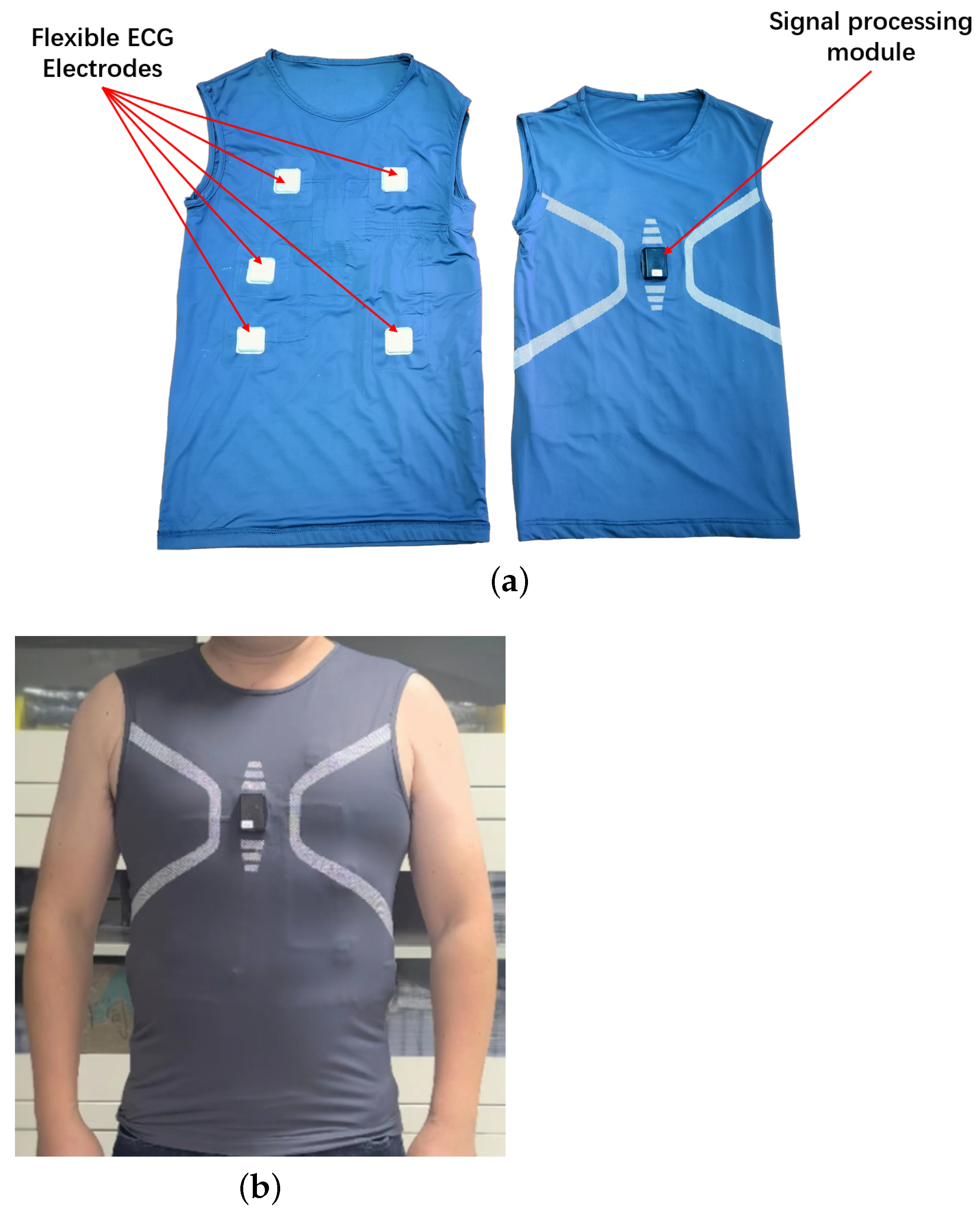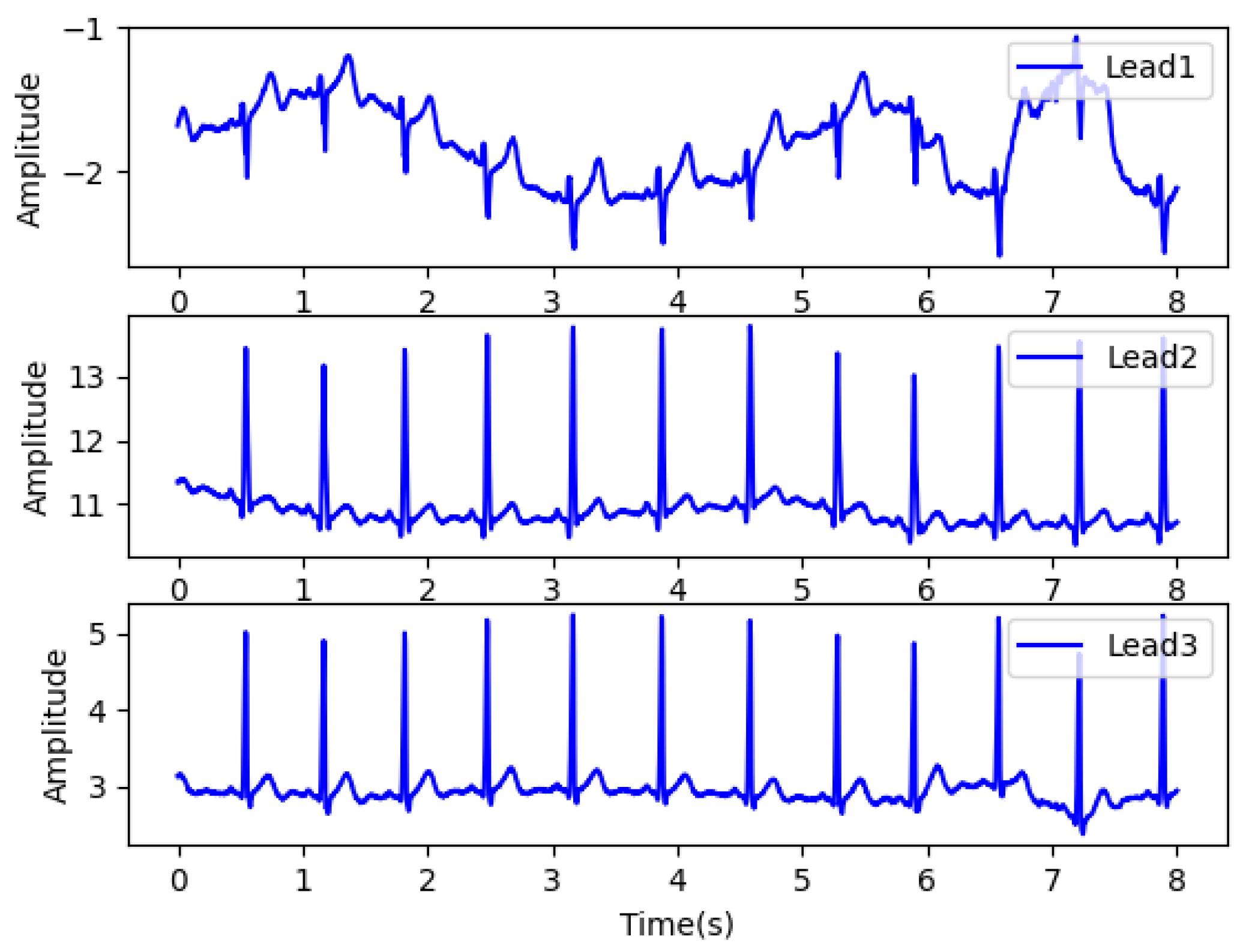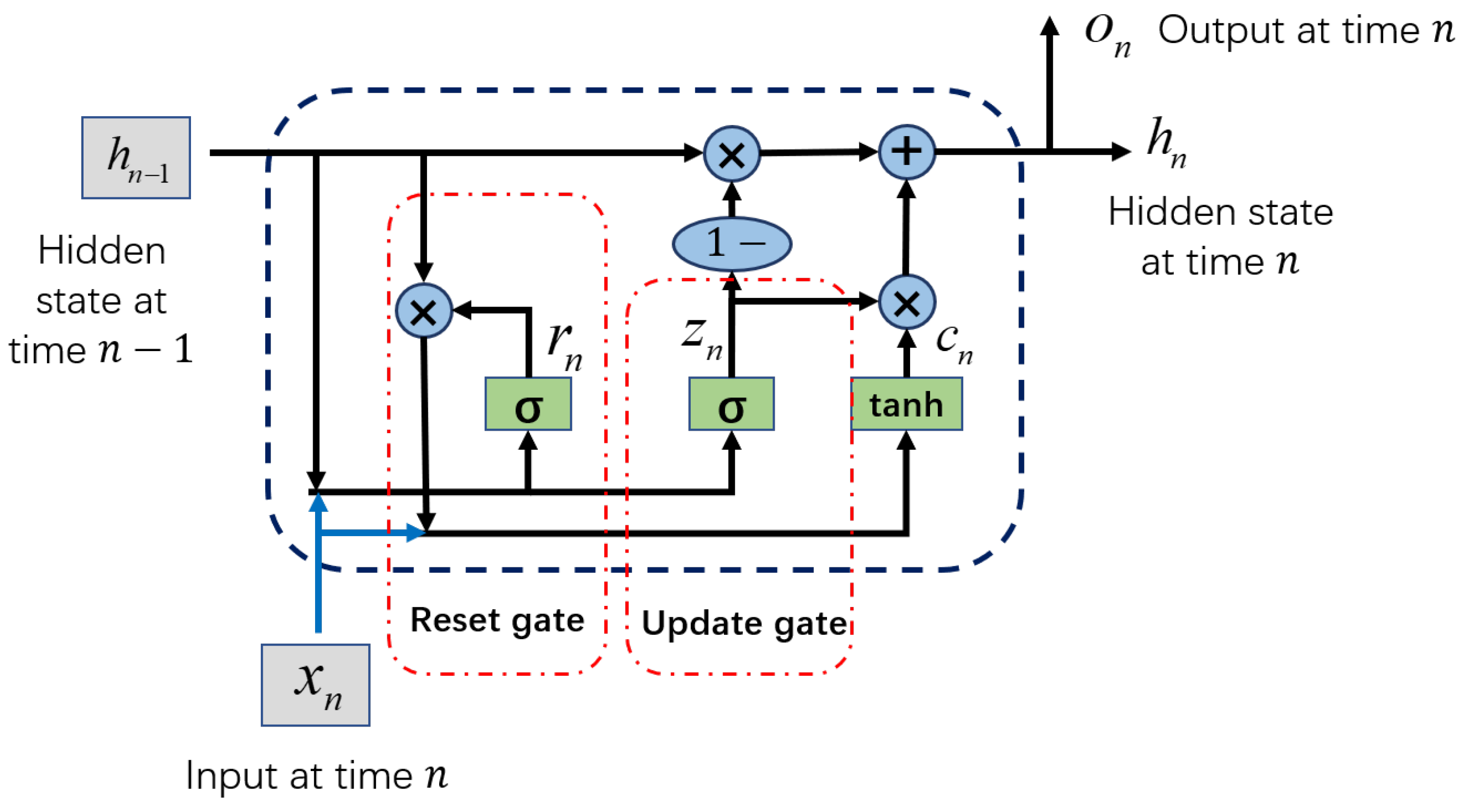Gated Recurrent Unit Network for Psychological Stress Classification Using Electrocardiograms from Wearable Devices
Abstract
:1. Introduction
2. Related Works
3. Materials
3.1. Smart ECG T-Shirt
3.2. VR Scenarios and Tasks
3.3. Experimental Procedure and Dataset
4. Proposed Method
4.1. HRV Feature Extraction
4.2. Data Preprocessing
4.3. GRU Model
4.4. Psychological Stress Classification Model
4.5. Evaluation Indicators
5. Experiments and Results
5.1. Experimental Setting and Parameters
5.2. Experimental Platform
5.3. Results and Analysis
6. Conclusions
Author Contributions
Funding
Institutional Review Board Statement
Informed Consent Statement
Data Availability Statement
Conflicts of Interest
References
- Blaug, R.; Kenyon, A.; Lekhi, R. Stress at Work: A Report Prepared for The Work Foundation’s Principal Partners. Project Report. The Work Foundation, London. 2007. Available online: https://www.researchgate.net/publication/274040847_Structural_Equation_Modeling_of_Occupational_Stress_in_the_Construction_Industry (accessed on 2 November 2022).
- Cohen, S.; Kessler, R.; Gordon, L.G. Strategies for measuring stress in studies of psychiatric and physical disorder. Meas. Stress. Guide Health Soc. Sci. 1995, 141, 3–26. [Google Scholar]
- McEwen, B.S. Central effects of stress hormones in health and disease: Understanding the protective and damaging effects of stress and stress mediators. Eur. J. Pharmacol. 2008, 583, 174–185. [Google Scholar] [CrossRef] [PubMed] [Green Version]
- Duman, R.S. Neurobiology of stress, depression, and rapid acting antidepressants: Remodeling synaptic connections. Depress. Anxiety 2014, 31, 291–296. [Google Scholar] [CrossRef] [PubMed] [Green Version]
- Lin, H.; Jia, J.; Guo, Q.; Xue, Y.; Huang, J.; Cai, L.; Feng, L. Psychological stress detection from cross-media microblog data using Deep Sparse Neural Network. In Proceedings of the 2014 IEEE International Conference on Multimedia and Expo (ICME), Chengdu, China, 14–18 July 2014; pp. 1–6. [Google Scholar] [CrossRef]
- Tajuddin, M.; Kabeer, M.; Misbahuddin, M. Analysis of Social Media for Psychological Stress Detection using Ontologies. In Proceedings of the 2020 Fourth International Conference on Inventive Systems and Control (ICISC), Coimbatore, India, 8–10 January 2020; pp. 181–185. [Google Scholar] [CrossRef]
- Giannakakis, G.; Grigoriadis, D.; Giannakaki, K.; Simantiraki, O.; Roniotis, A.; Tsiknakis, M. Review on Psychological Stress Detection Using Biosignals. IEEE Trans. Affect. Comput. 2022, 13, 440–460. [Google Scholar] [CrossRef]
- He, B.; Yang, L.; Wilke, C.; Yuan, H. Electrophysiological Imaging of Brain Activity and Connectivity—Challenges and Opportunities. IEEE Trans. Biomed. Eng. 2011, 58, 1918–1931. [Google Scholar] [CrossRef] [Green Version]
- Curone, D.; Secco, E.L.; Tognetti, A.; Loriga, G.; Dudnik, G.; Risatti, M.; Whyte, R.; Bonfiglio, A.; Magenes, G. Smart Garments for Emergency Operators: The ProeTEX Project. IEEE Trans. Inf. Technol. Biomed. 2010, 14, 694–701. [Google Scholar] [CrossRef]
- Lee, Y.D.; Chung, W.Y. Wireless sensor network based wearable smart shirt for ubiquitous health and activity monitoring. Sens. Actuators Chem. 2009, 140, 390–395. [Google Scholar] [CrossRef]
- Chen, C.C.; Lin, S.Y.; Chang, W.Y. Novel Stable Capacitive Electrocardiogram Measurement System. Sensors 2021, 21, 3668. [Google Scholar] [CrossRef]
- Liu, H.; Hartmann, Y.; Schultz, T. A Practical Wearable Sensor-Based Human Activity Recognition Research Pipeline. In Proceedings of the 15th International Joint Conference on Biomedical Engineering Systems and Technologies—Volume 5: HEALTHINF, Online, 9–11 February 2022; pp. 847–856. [Google Scholar] [CrossRef]
- Liu, H.; Hartmann, Y.; Schultz, T. CSL-SHARE: A Multimodal Wearable Sensor-Based Human Activity Dataset. Front. Comput. Sci. 2021, 3, 90. [Google Scholar] [CrossRef]
- Hartmann, Y.; Liu, H.; Schultz, T. Interactive and Interpretable Online Human Activity Recognition. In Proceedings of the PERCOM 2022—20th IEEE International Conference on Pervasive Computing and Communications Workshops and Other Affiliated Events (PerCom Workshops), Pisa, Italy, 21–25 March 2022; pp. 109–111. [Google Scholar] [CrossRef]
- Hartmann, Y.; Liu, H.; Lahrberg, S.; Schultz, T. Interpretable High-Level Features for Human Activity Recognition. In Proceedings of the 15th International Joint Conference on Biomedical Engineering Systems and Technologies—Volume 4: BIOSIGNALS, Online, 9–11 February 2022; pp. 40–49. [Google Scholar] [CrossRef]
- Smeets, T.; Cornelisse, S.; Quaedflieg, C.W.E.M.; Meyer, T.; Jelicic, M.; Merckelbach, H. Introducing the Maastricht Acute Stress Test (MAST): A quick and non-invasive approach to elicit robust autonomic and glucocorticoid stress responses. Psychoneuroendocrinology 2012, 37, 1998–2008. [Google Scholar] [CrossRef]
- Nitzan, M.; Babchenko, A.; Khanokh, B.; Landau, D. The variability of the photoplethysmographic signal—A potential method for the evaluation of the autonomic nervous system. Physiol. Meas. 1998, 19, 93–102. [Google Scholar] [CrossRef] [PubMed]
- Guo, H.W.; Huang, Y.S.; Lin, C.H.; Chien, J.C.; Haraikawa, K.; Shieh, J.S. Heart Rate Variability Signal Features for Emotion Recognition by Using Principal Component Analysis and Support Vectors Machine. In Proceedings of the 2016 IEEE 16th International Conference on Bioinformatics and Bioengineering (BIBE), Taichung, Taiwan, 31 October–2 November 2016; pp. 274–277. [Google Scholar] [CrossRef]
- Betti, S.; Lova, R.M.; Rovini, E.; Acerbi, G.; Santarelli, L.; Cabiati, M.; Ry, S.D.; Cavallo, F. Evaluation of an Integrated System of Wearable Physiological Sensors for Stress Monitoring in Working Environments by Using Biological Markers. IEEE Trans. Biomed. Eng. 2018, 65, 1748–1758. [Google Scholar] [CrossRef] [PubMed]
- Peláez, M.D.C.; Albalate, M.T.L.; Sanz, A.H.; Vallés, M.A.; Gil, E. Photoplethysmographic Waveform Versus Heart Rate Variability to Identify Low-Stress States: Attention Test. IEEE J. Biomed. Health Inform. 2019, 23, 1940–1951. [Google Scholar] [CrossRef] [Green Version]
- Giannakakis, G.; Marias, K.; Tsiknakis, M. A stress recognition system using HRV parameters and machine learning techniques. In Proceedings of the 2019 8th International Conference on Affective Computing and Intelligent Interaction Workshops and Demos (ACIIW), Cambridge, UK, 3–6 September 2019; pp. 269–272. [Google Scholar] [CrossRef]
- Malhotra, V.; Sandhu, M. Improved ECG based Stress Prediction using Optimization and Machine Learning Techniques. ICST Trans. Scalable Inf. Syst. 2021, 8, 169175. [Google Scholar] [CrossRef]
- Dalmeida, K.; Masala, G. HRV Features as Viable Physiological Markers for Stress Detection Using Wearable Devices. Sensors 2021, 21, 2873. [Google Scholar] [CrossRef]
- Giannakakis, G.; Trivizakis, E.; Tsiknakis, M.; Marias, K. A novel multi-kernel 1D convolutional neural network for stress recognition from ECG. In Proceedings of the 2019 8th International Conference on Affective Computing and Intelligent Interaction Workshops and Demos (ACIIW), Cambridge, UK, 3–6 September 2019; pp. 1–4. [Google Scholar] [CrossRef]
- Nita, S.; Bitam, S.; Mellouk, A. A Body Area Network for Ubiquitous Driver Stress Monitoring based on ECG Signal. In Proceedings of the 2019 International Conference on Wireless and Mobile Computing, Networking and Communications (WiMob), Barcelona, Spain, 21–23 October 2019; pp. 1–6. [Google Scholar] [CrossRef]
- Shao, S.; Zhou, Q.; Liu, Z. A New Assessment Method of the Pilot Stress Using ECG Signals During Complex Special Flight Operation. IEEE Access 2019, 7, 185360–185368. [Google Scholar] [CrossRef]
- Attar, E.T.; Balasubramanian, V.; Subasi, E.; Kaya, M. Stress Analysis Based on Simultaneous Heart Rate Variability and EEG Monitoring. IEEE J. Transl. Eng. Health Med. 2021, 9, 1–7. [Google Scholar] [CrossRef]
- Liew, W.S.; Seera, M.; Loo, C.K.; Lim, E.; Kubota, N. Classifying Stress From Heart Rate Variability Using Salivary Biomarkers as Reference. IEEE Trans. Neural Netw. Learn. Syst. 2016, 27, 2035–2046. [Google Scholar] [CrossRef]
- Ahmad, Z.; Khan, N.M. Multi-level Stress Assessment Using Multi-domain Fusion of ECG Signal. In Proceedings of the 2020 42nd Annual International Conference of the IEEE Engineering in Medicine and Biology Society (EMBC), Virtual, 20–24 July 2020; pp. 4518–4521. [Google Scholar] [CrossRef]
- Behinaein, B.; Bhatti, A.; Rodenburg, D.; Hungler, P.; Etemad, A. A transformer architecture for stress detection from ecg. In Proceedings of the 2021 International Symposium on Wearable Computers, Virtual, 21–26 September 2021; pp. 132–134. [Google Scholar]
- He, J.; Li, K.; Liao, X.; Zhang, P.; Jiang, N. Real-Time Detection of Acute Cognitive Stress Using a Convolutional Neural Network From Electrocardiographic Signal. IEEE Access 2019, 7, 42710–42717. [Google Scholar] [CrossRef]
- Hai, D.; Chen, C.; Yi, R.; Gou, S.; Yu Su, B.; Jiao, C.; Skubic, M. Heartbeat Detection and Rate Estimation from Ballistocardiograms using the Gated Recurrent Unit Network. In Proceedings of the 2020 42nd Annual International Conference of the IEEE Engineering in Medicine and Biology Society (EMBC), Montreal, QC, Canada, 20–24 July 2020; pp. 451–454. [Google Scholar] [CrossRef]
- Jiao, C.; Chen, C.; Gou, S.; Hai, D.; Su, B.Y.; Skubic, M.; Jiao, L.; Zare, A.; Ho, K.C. Non-Invasive Heart Rate Estimation From Ballistocardiograms Using Bidirectional LSTM Regression. IEEE J. Biomed. Health Inform. 2021, 25, 3396–3407. [Google Scholar] [CrossRef]
- Zhong, J.; Zhou, H.; Liu, Y.; Cheng, X.; Cai, L.; Zhu, W.; Liu, L. Integrated Design Of Physiological Multi-Parameter Sensors On A Smart Garment By Ultra-Elastic E-Textile. J. Mech. Med. Biol. 2021, 21, 2140037. [Google Scholar] [CrossRef]
- Chung, J.; Gulcehre, C.; Cho, K.; Bengio, Y. Gated Feedback Recurrent Neural Networks. In Proceedings of the International conference on machine learning, Lille, France, 6–11 July 2015; pp. 2067–2075. [Google Scholar]
- Graves, A. Supervised Sequence Labelling. In Supervised Sequence Labelling with Recurrent Neural Networks; Springer: Berlin/Heidelberg, Germany, 2012; pp. 5–13. [Google Scholar] [CrossRef]
- Chung, J.; Gulcehre, C.; Cho, K.; Bengio, Y. Empirical Evaluation of Gated Recurrent Neural Networks on Sequence Modeling. In Proceedings of the NIPS 2014 Workshop on Deep Learning, Montreal, QC, Canada, 8–13 December 2014. [Google Scholar]
- Chen, T.; Guestrin, C. Xgboost: A Scalable Tree Boosting System. In Proceedings of the 22nd ACM Sigkdd International Conference on Knowledge Discovery and Data Mining, San Francisco, CA, USA, 13–17 August 2016; pp. 785–794. [Google Scholar]
- Vijayvargiya, A.; Khimraj; Kumar, R.; Dey, N. Voting-based 1D CNN model for human lower limb activity recognition using sEMG signal. Phys. Eng. Sci. Med. 2021, 44, 1297–1309. [Google Scholar] [CrossRef] [PubMed]
- Wu, B.; Yang, G.; Yang, L.; Yin, Y. Robust ECG Biometrics Using Two-Stage Model. In Proceedings of the 2018 24th International Conference on Pattern Recognition (ICPR), Beijing, China, 20–24 August 2018; pp. 1062–1067. [Google Scholar] [CrossRef]
- Hinton, G.E. Visualizing High-Dimensional Data Using t-SNE. Vigiliae Christ. 2008, 9, 2579–2605. [Google Scholar]
- Saito, K.; Watanabe, K.; Ushiku, Y.; Harada, T. Maximum Classifier Discrepancy for Unsupervised Domain Adaptation. In Proceedings of the 2018 IEEE/CVF Conference on Computer Vision and Pattern Recognition, Salt Lake City, UT, USA, 18–23 June 2018; pp. 3723–3732. [Google Scholar] [CrossRef] [Green Version]
- Zhao, L.M.; Yan, X.; Lu, B.L. Plug-and-play domain adaptation for cross-subject EEG-based emotion recognition. In Proceedings of the AAAI Conference on Artificial Intelligence, Virtually, 2–9 February 2021; Volume 35, pp. 863–870. [Google Scholar] [CrossRef]
- Hartmann, Y.; Liu, H.; Schultz, T. Feature Space Reduction for Human Activity Recognition based on Multi-channel Biosignals. In Proceedings of the 14th International Joint Conference on Biomedical Engineering Systems and Technologies, Vienna, Austria, 11–13 February 2021; pp. 215–222. [Google Scholar] [CrossRef]










| Feature | Description |
|---|---|
| mRR | The mean value of the RR interval (time between adjacent heartbeats) sequence. |
| SDNN | The standard deviation of RR intervals (time series of adjacent heartbeat intervals). |
| HFn | Normalized spectral energy of heart rate variability from 0.15 to 0.4 Hz. |
| LFn | Normalized spectral energy of heart rate variability from 0.04 to 0.15 Hz. |
| LF/HF | The ratio of low-frequency to high-frequency power for heart rate variability. |
| ApEn | The approximate entropy of the RR interval sequence, which is used to measure the complexity of the sequence. |
| SD1/SD2 | In the point cloud data of the poincare plots drawn with the RR intervals, the variance of the distribution along the longer axis is SD2, and the variance of the distribution along the shorter axis is SD1. SD1/SD2 is the ratio of SD1 and SD2. |
| Features | Accuracy |
|---|---|
| mRR, ApEn | 0.51 |
| mRR, ApEn, SD1/SD2 | 0.56 |
| mRR, ApEn, SD1/SD2, SDNN | 0.68 |
| mRR, ApEn, SD1/SD2, SDNN, HFn | 0.67 |
| mRR, ApEn, SD1/SD2, SDNN, HFn, LFn | 0.71 |
| mRR, ApEn, SD1/SD2, SDNN, HFn, LFn, LF/HF | 0.73 |
| Algorithms | KNN | XGBoost | MLP [23] | CNN-1D | GRU-b1 | GRU-b2 | GRU-b3 |
|---|---|---|---|---|---|---|---|
| Accuracy | 0.65 | 0.69 | 0.71 | 0.7 | 0.73 | 0.78 | 0.77 |
| The number of GRU units | 64 | 128 | 256 | 512 |
| Accuracy | 0.75 | 0.75 | 0.78 | 0.73 |
| The number of layers of GRU block | 1 | 3 | 5 | 7 |
| Accuracy | 0.67 | 0.7 | 0.78 | 0.76 |
| Proportion | Predict Labels | 1 | 2 | 3 | 4 | |
|---|---|---|---|---|---|---|
| True Labels | ||||||
| 1 | 0.56 | 0.06 | 0 | 0.38 | ||
| 2 | 0 | 0.88 | 0.06 | 0.06 | ||
| 3 | 0.06 | 0 | 0.94 | 0 | ||
| 4 | 0.13 | 0.06 | 0 | 0.81 | ||
Publisher’s Note: MDPI stays neutral with regard to jurisdictional claims in published maps and institutional affiliations. |
© 2022 by the authors. Licensee MDPI, Basel, Switzerland. This article is an open access article distributed under the terms and conditions of the Creative Commons Attribution (CC BY) license (https://creativecommons.org/licenses/by/4.0/).
Share and Cite
Zhong, J.; Liu, Y.; Cheng, X.; Cai, L.; Cui, W.; Hai, D. Gated Recurrent Unit Network for Psychological Stress Classification Using Electrocardiograms from Wearable Devices. Sensors 2022, 22, 8664. https://doi.org/10.3390/s22228664
Zhong J, Liu Y, Cheng X, Cai L, Cui W, Hai D. Gated Recurrent Unit Network for Psychological Stress Classification Using Electrocardiograms from Wearable Devices. Sensors. 2022; 22(22):8664. https://doi.org/10.3390/s22228664
Chicago/Turabian StyleZhong, Jun, Yongfeng Liu, Xiankai Cheng, Liming Cai, Weidong Cui, and Dong Hai. 2022. "Gated Recurrent Unit Network for Psychological Stress Classification Using Electrocardiograms from Wearable Devices" Sensors 22, no. 22: 8664. https://doi.org/10.3390/s22228664
APA StyleZhong, J., Liu, Y., Cheng, X., Cai, L., Cui, W., & Hai, D. (2022). Gated Recurrent Unit Network for Psychological Stress Classification Using Electrocardiograms from Wearable Devices. Sensors, 22(22), 8664. https://doi.org/10.3390/s22228664







